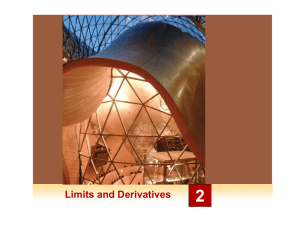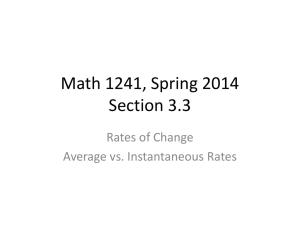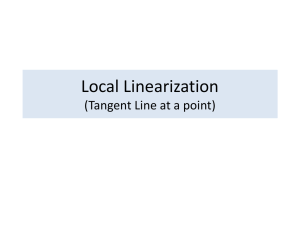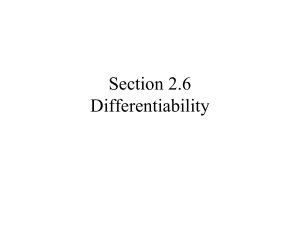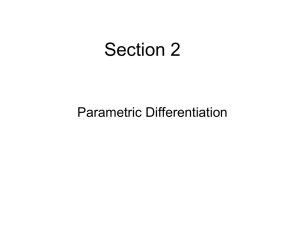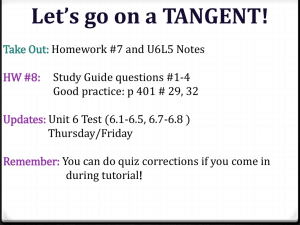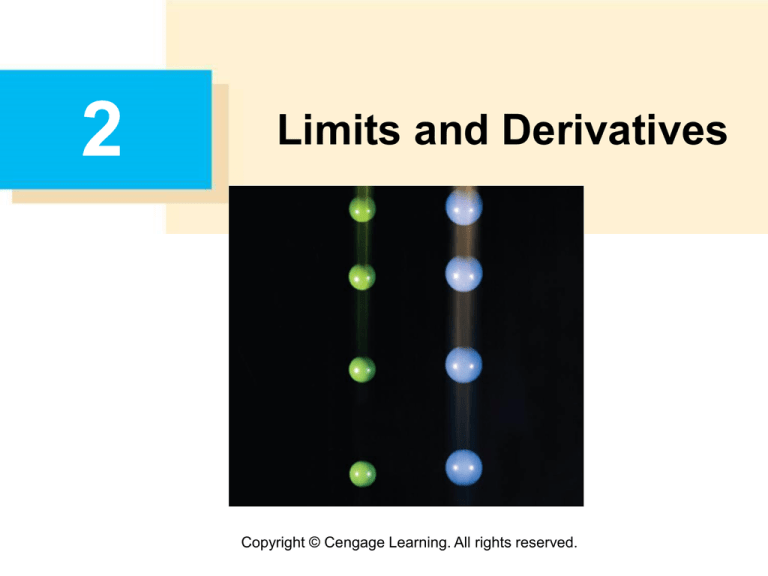
2
Limits and Derivatives
Copyright © Cengage Learning. All rights reserved.
2.1
The Tangent and Velocity
Problems
Copyright © Cengage Learning. All rights reserved.
The Tangent Problem
3
The Tangent Problems
The word tangent is derived from the Latin word tangens,
which means “touching.”
Thus a tangent to a curve is a line that touches the curve.
In other words, a tangent line should have the same
direction as the curve at the point of contact.
4
The Tangent Problems
For a circle we could simply follow Euclid and say that a
tangent is a line that intersects the circle once and only
once, as in Figure 1(a).
Figure 1(a)
For more complicated curves this definition is inadequate.
5
The Tangent Problems
Figure 1(b) shows two lines l and t passing through a point
P on a curve C.
The line l intersects
C only once, but it
certainly does not
look like what we
think of as a tangent.
Figure 1(b)
The line t, on the other hand, looks like a tangent but it
intersects C twice.
6
Example 1
Find an equation of the tangent line to the parabola y = x2
at the point P(1, 1).
Solution:
We will be able to find an equation of the tangent line t as
soon as we know its slope m.
The difficulty is that we know only one point, P, on t,
whereas we need two points to compute the slope.
7
Example 1 – Solution
cont’d
But observe that we can compute an approximation to m by
choosing a nearby point Q(x, x2) on the parabola (as in
Figure 2) and computing the slope mPQ of the secant
line PQ. [A secant line, from the Latin word secans,
meaning cutting, is a line that cuts (intersects) a curve
more than once.]
Figure 2
8
Example 1 – Solution
cont’d
We choose x 1 so that Q P . Then
For instance, for the point Q(1.5, 2.25) we have
9
Example 1 – Solution
cont’d
The following tables show the values of mPQ for several
values of x close to 1.
The closer Q is to P, the closer x is to 1 and, it appears
from the tables, the closer mPQ is to 2.
10
Example 1 – Solution
cont’d
This suggests that the slope of the tangent line t should be
m = 2.
We say that the slope of the tangent line is the limit of the
slopes of the secant lines, and we express this symbolically
by writing
and
Assuming that the slope of the tangent line is indeed 2, we
use the point-slope form of the equation of a line to write
the equation of the tangent line through (1, 1) as
y – 1 = 2(x – 1)
or
y = 2x – 1
11
Example 1 – Solution
cont’d
Figure 3 illustrates the limiting process that occurs in this
example.
Q approaches P from the right
Figure 3
12
Example 1 – Solution
cont’d
Q approaches P from the left
Figure 3
As Q approaches P along the parabola, the corresponding
secant lines rotate about P and approach the tangent line t.
13
The Velocity Problem
14
Example 3
Suppose that a ball is dropped from the upper observation
deck of the CN Tower in Toronto, 450 m above the ground.
Find the velocity of the ball after 5 seconds.
Solution:
Through experiments carried out four centuries ago,
Galileo discovered that the distance fallen by any freely
falling body is proportional to the square of the time it has
been falling. (This model for free fall neglects air
resistance.)
15
Example 3 – Solution
cont’d
If the distance fallen after t seconds is denoted by s(t) and
measured in meters, then Galileo’s law is expressed by the
equation
s(t) = 4.9t 2
The difficulty in finding the velocity after 5 s is that we are
dealing with a single instant of time (t = 5), so no time
interval is involved.
16
Example 3 – Solution
cont’d
However, we can approximate the desired quantity by
computing the average velocity over the brief time interval
of a tenth of a second from t = 5 to t = 5.1:
17
Example 3 – Solution
cont’d
The following table shows the results of similar calculations
of the average velocity over successively smaller time
periods.
18
Example 3 – Solution
cont’d
It appears that as we shorten the time period, the average
velocity is becoming closer to 49 m/s.
The instantaneous velocity when t = 5 is defined to be
the limiting value of these average velocities over shorter
and shorter time periods that start at t = 5.
Thus the (instantaneous) velocity after 5 s is
v = 49 m/s
19


